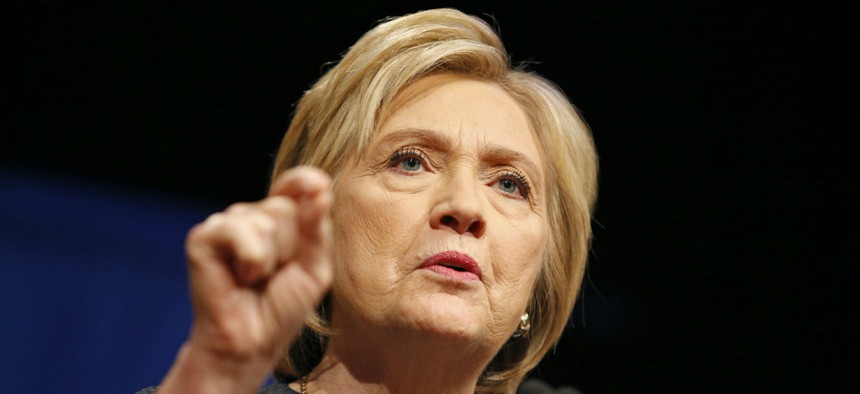
Democratic presidential candidate Hillary Clinton John Locher/AP
The Trump-Clinton Race Is Not As Close As It Looks
With its nomination settled, the GOP has been healing its wounds, but Democratic feelings are still raw because of the ongoing fight between Clinton and Sanders.
The latest round of polls released prior to Memorial Day weekend, which showed Hillary Clinton and Donald Trump in a virtual tie, set off intense hand-wringing among Democrats, Clinton backers, and Trump detractors alike. They much preferred the polls from a month earlier giving the former secretary of State a double-digit lead over the real-estate mogul.
What’s lost on many people is that any trial heat between Trump and Clinton today is like comparing apples and oranges. Trump’s nomination fight is over while Clinton’s contest is still at a messy stage. Republicans who backed one of the 16 other GOP candidates have coalesced to a significant degree, painfully progressing through Elizabeth Kübler-Ross’s five stages of grief: denial, anger, bargaining, depression, and acceptance.
Many establishment figures, who I never thought would come to terms with Trump as the GOP nominee, have now moved to healing and closure, if somewhat reluctantly. They are quick to point out that Trump wasn’t their first choice, but, when the bugle sounded, they and other party war horses got in line. Sometimes it was more a matter of lining up against Clinton rather than behind Trump, and some even found it difficult to endorse Trump by name. One former Republican senator compared Trump to the villainous Harry Potter character Lord Voldemort, “he who must not be named.” Even so, most partisans ultimately get behind their candidate, for better or worse, and so it is with today’s Republicans.
By contrast, many of Bernie Sanders’s supporters still seem be in the denial and anger stages. Feelings are still raw, and the healing process has not yet begun. But after the last round of primaries on June 7, most of them will also move from depression to acceptance.
On NBC’s Meet the Press on Sunday, the always-prescient moderator Chuck Todd said much the same thing but approached it in another way. First Todd pointed to the May 15-19 NBC News/Wall Street Journalpoll, noting that Sanders bested Trump in the survey by 15 points, 54 to 39 percent, while Clinton had a scant 3-point edge over Trump, 46 to 43 percent. Todd then calculated that if 70 percent of the voters who supported Sanders against Trump subsequently moved into Clinton’s corner, she would then have an 8-point lead, 51 to 43 percent.
Shifting 70 percent of Sanders’s supporters into the Clinton column in the May 13-17 CBS News/New York Times poll would enlarge her lead over Trump from 6 points, 47 to 41 percent, to 9 points, 50 to 41 percent. Doing the same thing using the May 14-17 Fox News survey, which showed Trump ahead by 3 points, 45 to 42 percent, would produce a tie, 45 to 45 percent. Todd pointed out that in the first 2008 NBC/WSJ poll after Clinton dropped out against Barack Obama, Obama moved up 3 points, a sign that Clinton supporters were getting in line. This is a natural development after contested nominations are settled.
Keeping in mind that there are more Democrats than Republicans, and that 90 percent of partisans end up voting for their respective party’s presidential nominee, it’s not surprising that Democrats have had party identification advantages in four of the five most recent national polls: 2 points in CBS/NYT (33 to 31 percent), 5 points in NBC/WSJ (34 to 29 percent), 6 points in Gallup (31 to 25 percent), and 8 points in ABC/Washington Post (33 to 25 percent); only the Fox News poll gave the GOP an edge in party affiliation, 41 to 40 percent.
So it is logical that Democrats have an advantage of a few points once the nominations are truly settled and partisans have had time to make peace with their candidates. In the NBC/WSJ poll, a generic presidential race showed 47 percent preferring a Democratic president to 43 percent opting for a Republican. Likewise, when pollsters measure favorable-unfavorable or positive-negative ratings, Democrats maintain a steady advantage over Republicans.
In short, the parties have not evolved at the same rate. Trump has had the Republican field to himself and has begun healing party wounds, such as he can, while Clinton has not yet been afforded that opportunity because she has been busy fighting off Sanders.
It is exceedingly unlikely that Clinton will beat Trump by a wide margin because of her high negatives and the intense partisanship that has gripped the nation, but the probabilities still are in her favor. We are approaching a moment similar to the one in The Wizard of Oz when Dorothy told her dog Toto that “we’re not in Kansas anymore.” No longer are we looking at a Republican nomination fight with an electorate dominated by the tea party. We are beginning to focus on a November electorate that is broader, more diverse, and considerably more moderate, in both ideology and temperament, than the one that selected Donald Trump. Chances are high that these voters will behave much differently than the ones in the GOP primaries.






